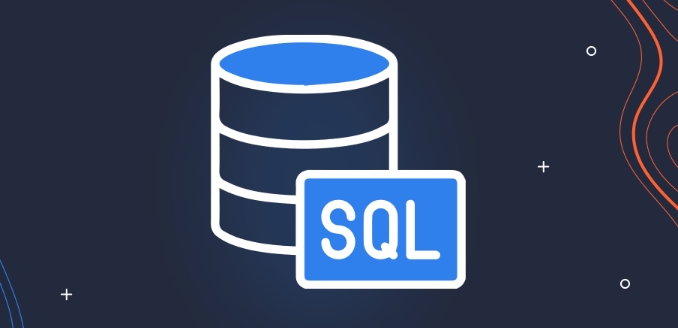What are the different types of SQL commands (DDL, DML, DCL, TCL)?
SQL commands are mainly divided into four categories: DDL, DML, DCL and TCL. 1. DDL (data definition language) is used to define database structure, including CREATE, ALTER, DROP, TRUNCATE and other commands; 2. DML (data operation language) is used to operate data, including SELECT, INSERT, UPDATE, DELETE; 3. DCL (data control language) is used to define permission management, including GRANT and REVOKE; 4. TCL (transaction control language) is used to process transactions, including COMMIT, ROLLBACK and SAVEPOINT. These categories correspond to different management and operational functions of the database.

SQL commands are broadly categorized into four types based on their functionality: DDL, DML, DCL, and TCL. Each category serves a specific purpose in managing and manipulating databases.

Data Definition Language (DDL)
DDL commands are used to define the structure of database objects, such as tables and schemas. These commands primarily deal with the creation, alteration, and deletion of database structures. Common DDL commands include:

- CREATE : Used to create new database objects like tables or views.
- ALTER : Modifies existing database objects, such as adding or removing columns from a table.
- DROP : Deletes entire database objects, such as tables or indexes.
- TRUNCATE : Removes all records from a table but keeps the table structure intact.
For example, when you run CREATE TABLE users (id INT, name VARCHAR(50)); , you're defining a new table called "users" with two columns. These commands are essential during the setup or restructuring phase of a database.
Data Manipulation Language (DML)
DML commands are focused on manipulating data within database objects. They allow users to insert, update, delete, or retrieve data from tables. Key DML commands include:

- SELECT : Retrieves data from one or more tables.
- INSERT : Adds new rows of data into a table.
- UPDATE : Modifies existing data in a table.
- DELETE : Removes specific records from a table.
For instance, using SELECT * FROM users; fetches all the data stored in the "users" table. These commands are the workshors for interacting with data once the database structure is in place.
Data Control Language (DCL)
DCL commands are concerned with access control and permissions in a database. They help manage who can perform specific actions on database objects. The main DCL commands are:
- GRANT : Provides specific privileges to users or roles.
- REVOKE : Removes previously granted privileges from users or roles.
For example, if you want to give a user permission to select data from a table, you might use GRANT SELECT ON users TO username; . These commands are cruel for maintaining security and ensuring that only authorized users can perform certain tasks.
Transaction Control Language (TCL)
TCL commands manage transactions in a database, ensuring data integrity and consistency during operations. Transactions are sequences of one or more SQL statements treated as a single unit of work. Common TCL commands include:
- COMMIT : Saves the current transaction permanently to the database.
- ROLLBACK : Undoes changes made during the current transaction.
- SAVEPOINT : Sets a point within a transaction that you can roll back to without rolling back the entire transaction.
For example, after making several updates, you could use COMMIT; to make those changes permanent. If something goes wrong, ROLLBACK; reverts everything back to the last committed state. These commands are especially important when dealing with critical operations where data accuracy matters.
Basically that's it.
The above is the detailed content of What are the different types of SQL commands (DDL, DML, DCL, TCL)?. For more information, please follow other related articles on the PHP Chinese website!

Hot AI Tools

Undress AI Tool
Undress images for free

Undresser.AI Undress
AI-powered app for creating realistic nude photos

AI Clothes Remover
Online AI tool for removing clothes from photos.

Clothoff.io
AI clothes remover

Video Face Swap
Swap faces in any video effortlessly with our completely free AI face swap tool!

Hot Article

Hot Tools

Notepad++7.3.1
Easy-to-use and free code editor

SublimeText3 Chinese version
Chinese version, very easy to use

Zend Studio 13.0.1
Powerful PHP integrated development environment

Dreamweaver CS6
Visual web development tools

SublimeText3 Mac version
God-level code editing software (SublimeText3)
 SQL for Predictive Analytics
Jul 20, 2025 am 02:02 AM
SQL for Predictive Analytics
Jul 20, 2025 am 02:02 AM
In predictive analysis, SQL can complete data preparation and feature extraction. The key is to clarify the requirements and use SQL functions reasonably. Specific steps include: 1. Data preparation requires extracting historical data from multiple tables and aggregating and cleaning, such as aggregating sales volume by day and associated promotional information; 2. The feature project can use window functions to calculate time intervals or lag features, such as obtaining the user's recent purchase interval through LAG(); 3. Data segmentation is recommended to divide the training set and test set based on time, such as sorting by date with ROW_NUMBER() and marking the collection type proportionally. These methods can efficiently build the data foundation required for predictive models.
 Edge Computing and SQL: Data Processing at the Edge
Jul 21, 2025 am 01:15 AM
Edge Computing and SQL: Data Processing at the Edge
Jul 21, 2025 am 01:15 AM
Using SQL to process data in edge computing scenarios becomes important because it reduces transmission pressure and speeds up response. Core reasons include data dispersion, latency sensitivity and limited resources. Challenges include resource constraints, diverse data formats, high real-time requirements and complex deployment and maintenance. The deployment process includes selecting a SQL engine suitable for the edge, accessing data sources, writing SQL scripts, and outputting results. Useful tips include using window functions, filtering and sampling, simplifying nested queries, using memory tables, and connecting external data sources.
 Relational Database Design Principles for SQL Developers
Jul 21, 2025 am 01:56 AM
Relational Database Design Principles for SQL Developers
Jul 21, 2025 am 01:56 AM
When designing a relational database, four key principles should be followed. First, correctly use primary and foreign key constraints to ensure data integrity and association accuracy; second, perform standardized design reasonably, usually reaching the third normal form (3NF), eliminating redundancy and ensuring data consistency; third, establishing appropriate indexes for common queries to improve query performance but avoid over-index; finally, using consistent naming specifications and structural styles to enhance readability and maintainability. Mastering these principles can help build a clear, efficient and robust database structure.
 SQL Serverless Computing Options
Jul 27, 2025 am 03:07 AM
SQL Serverless Computing Options
Jul 27, 2025 am 03:07 AM
SQLServer itself does not support serverless architecture, but the cloud platform provides a similar solution. 1. Azure's ServerlessSQL pool can directly query DataLake files and charge based on resource consumption; 2. AzureFunctions combined with CosmosDB or BlobStorage can realize lightweight SQL processing; 3. AWSathena supports standard SQL queries for S3 data, and charge based on scanned data; 4. GoogleBigQuery approaches the Serverless concept through FederatedQuery; 5. If you must use SQLServer function, you can choose AzureSQLDatabase's serverless service-free
 How do you calculate the difference between two dates in SQL?
Aug 02, 2025 pm 01:29 PM
How do you calculate the difference between two dates in SQL?
Aug 02, 2025 pm 01:29 PM
To calculate the difference between two dates, you need to select the corresponding function according to the database type: 1. Use DATEDIFF() to calculate the day difference in MySQL, or specify the units such as HOUR and MINUTE in TIMESTAMPDIFF(); 2. Use DATEDIFF(date_part, start_date, end_date) in SQLServer and specify the units; 3. Use direct subtraction in PostgreSQL to obtain the day difference, or use EXTRACT(DAYFROMAGE(...)) to obtain more accurate intervals; 4. Use julianday() function to subtract the day difference in SQLite; always pay attention to the date order
 Mastering SQL for Business Intelligence Analytics
Jul 26, 2025 am 07:53 AM
Mastering SQL for Business Intelligence Analytics
Jul 26, 2025 am 07:53 AM
TomasterSQLforBIanalytics,startbyunderstandingBIdatastructureslikefactanddimensiontables,thenusestrategicaggregationswithGROUPBYandHAVING,leveragedatefunctionsfortime-basedanalysis,andwriteclean,maintainablequeries.First,graspdimensionalmodelingtojoi
 Isolation Levels in SQL Server: Read Committed, Snapshot, Serializable
Jul 21, 2025 am 12:35 AM
Isolation Levels in SQL Server: Read Committed, Snapshot, Serializable
Jul 21, 2025 am 12:35 AM
ThethreemainSQLServerisolationlevels—ReadCommitted,Snapshot,andSerializable—differinconcurrencyandconsistency.1.ReadCommittedpreventsdirtyreadsbutallowsnon-repeatableandphantomreads,offersbalancedperformance,andcanuseRCSItoreduceblocking.2.Snapshotus
 How to format dates in SQL?
Jul 24, 2025 am 01:27 AM
How to format dates in SQL?
Jul 24, 2025 am 01:27 AM
Format dates in SQL, you need to select the corresponding function according to the database type. MySQL uses DATE_FORMAT() with %Y, %m and other formats, such as SELECTDATE_FORMAT(NOW(),'%Y-%m-%d'); SQLServer uses CONVERT() or FORMAT(), the former is SELECTCONVERT(VARCHAR,GETDATE(),112), and the latter is SELECTFORMAT(GETDATE(),'yyyy-MM-dd'); PostgreSQL uses TO_CHAR(), such as SELECTTO_CHAR(NOW(),'Y







